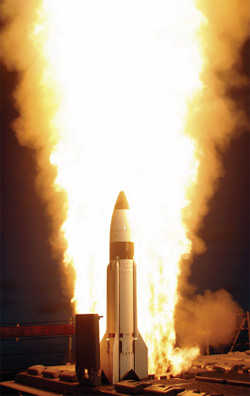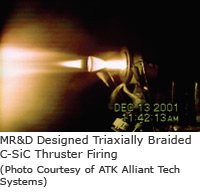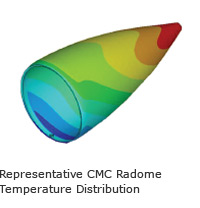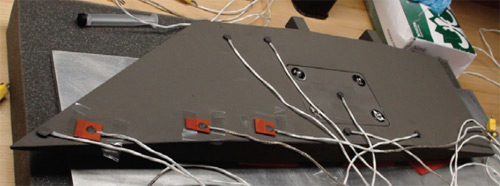- Expertise
- Our Work »
- SBIR / STTR
- Request A Quote
- Contact
Advanced Missile Components

MR&D is uniquely qualified to offer potential customers a full range of engineering services. We regularly provide design consultation, oversee testing of advanced materials, and carry out thermal, mechanical, vibration, acoustic, and dynamic analyses. These skill have been developed under numerous collaborations with the Navy and Air Force involving the design and anlysis of high speed, high temperature missile components.
Using advanced finite element analysis along with in-house material development tools, MR&D routinely performs detailed thermo-mechanical analyses to optimize high performance missile components. Our experience ensures a successful program from material selection, to testing, to deployment.
Non-Eroding Nozzle Materials
The operational environment within high performance rocket motors is very severe, especially in the throat region. Hot-walled materials may be required to operate at temperatures that approach 6000°F in a very aggressive thermal-chemical environment. Non-eroding throat insert materials can significantly improve the overall performance of the rocket motor compared to an eroding throat. Suitable non-eroding materials must meet the four following requirements:
- High melting temperature
- High resistance to mechanical erosion
- High resistance to chemical erosion
- Thermal shock resistance
Most materials that satisfy the first three requirements are inherently plagued with poor thermal shock resistance. It has been demonstrated through detailed analytical and experimental efforts, including test motor firings, that innovative designs are achievable in which the selected throat insert materials are capable of performing exceptionally well within these extreme environments when properly designed, fabricated, and assembled.
Nozzle Design and Analysis
The approach used for theoretically assessing the feasibility of advanced materials for rocket motor designs is briefly summarized by the following sequential steps:

- Identification of rocket motor geometry, materials, and operational environment
- Use of available material properties and, if necessary, in-house proprietary codes to develop complete, temperature dependent material properties
- Calculation of the thermal-structural loads
- Development of comprehensive thermal-structural finite element models
- Derivation of the necessary thermal-structural boundary conditions based on the overall rocket motor geometry and fixtures
- Calculation of transient temperatures, deformations, stresses, and strains for all materials
- Assessment of results with emphasis on determining the likelihood of melting materials, forming eutectic phases at material interfaces, thermal-chemical reactions, experiencing excessive deformations and exceeding allowable stress and strain limits
Radome and Antenna Window Design and Analysis

Future missile systems require more aggressive trajectories, operational capability in adverse weather and improved radar performance. This has led designers to consider high temperature composites (i.e. CMCs) in place of traditional monolithic ceramics for missile radomes. Compared to monolithic ceramics, CMCs offer improved strength and toughness coupled with graceful failure permitting their use in more demanding aerothermal and weather environments. MR&D has aided in the design and testing of CMC radome materials on several government missile programs. Tasks have included: definition of radome shapes and aerothermal flight loads necessary to assess the effects of aerodynamic heating and pressure on operational stresses; design of material testing plans to build material property databases; design and analysis of high temperature subcomponent testing to simulate radome operating conditions; and design and analysis of aft end attachment configurations and nose tip hardware. MR&D’s knowledge and expirence can help you maximize the potential of cutting edge composite materials for use in future high-speed missile platforms.
Missile Control Surfaces
MR&D has significant experience in the design and analysis of high temperature composite missile control surfaces. Improving the effective range of tactical missiles while minimizing flight time-to-target requires high rates of acceleration and hypersonic velocities which in turn requires lightweight materials that retain strength at high temperature. Current state-of-the-art, high temperature composite control surfaces are very costly. Under a Phase II SBIR, MR&D successfully designed a fully-composite control surface using innovative, low-cost CMCs. The result was a design with significant weight and cost savings compared to the current state-of-the-art. Full-scale test articles were also successfully tested using 150% design limit loads.

Low Cost CMC Control Surface (2010)